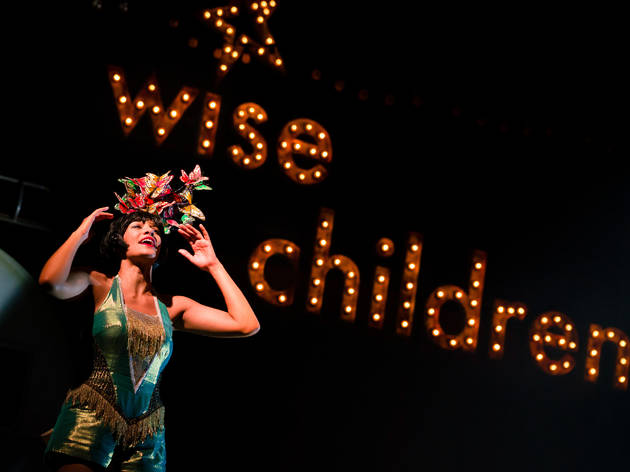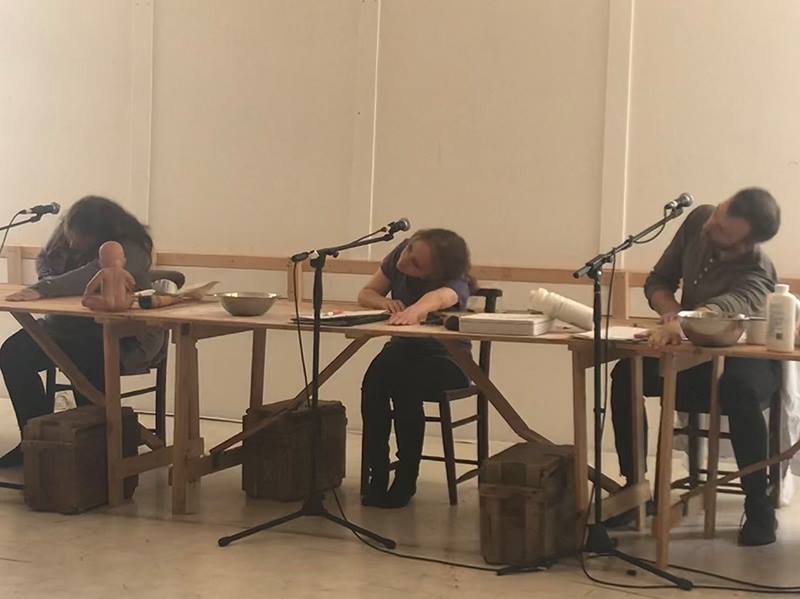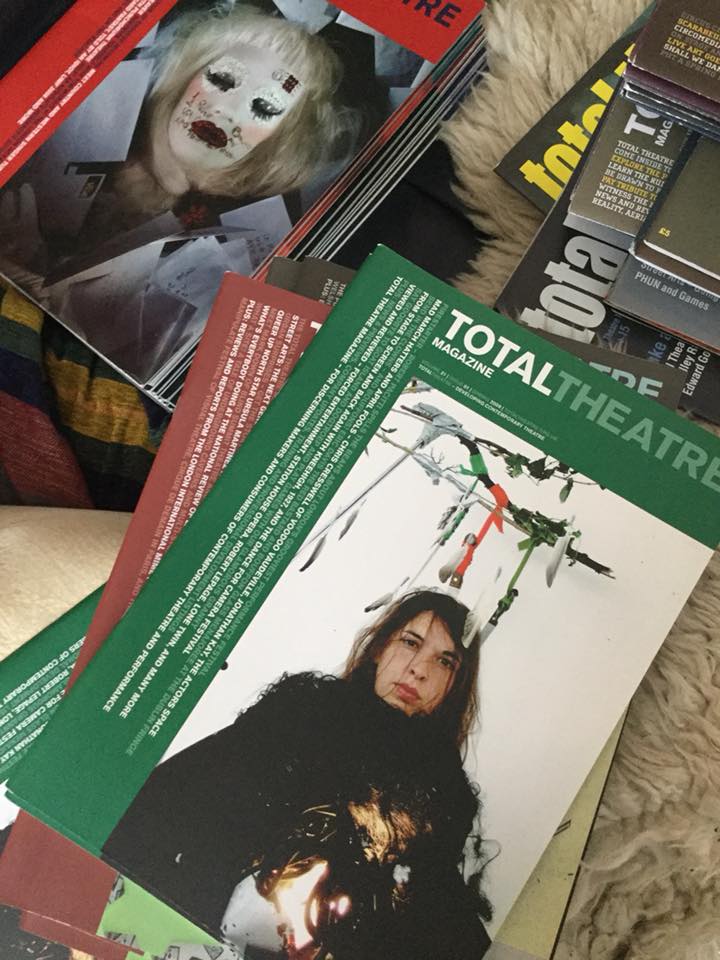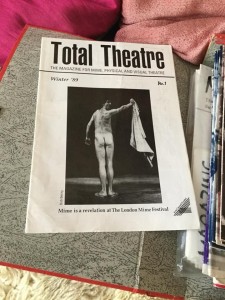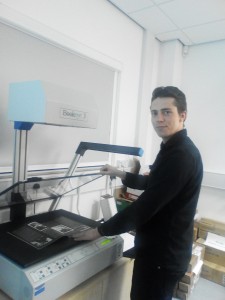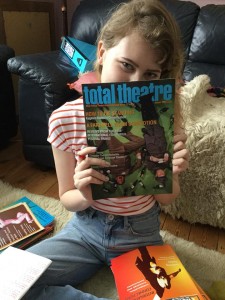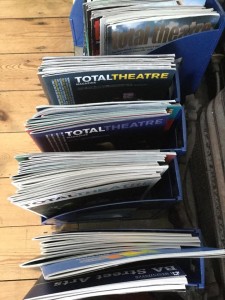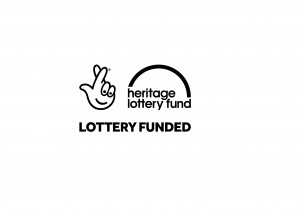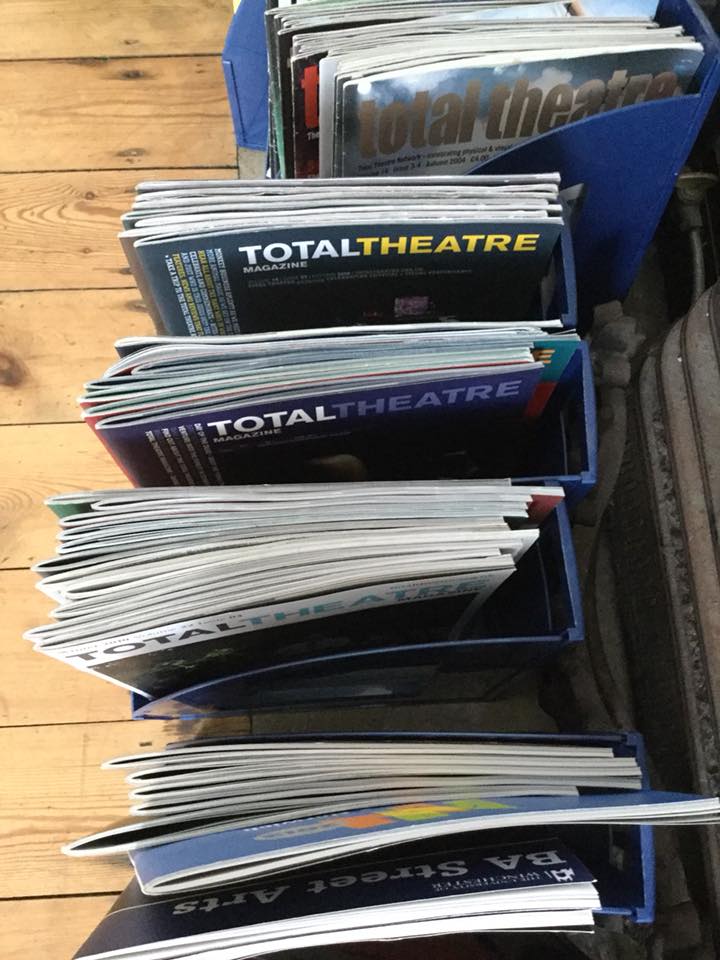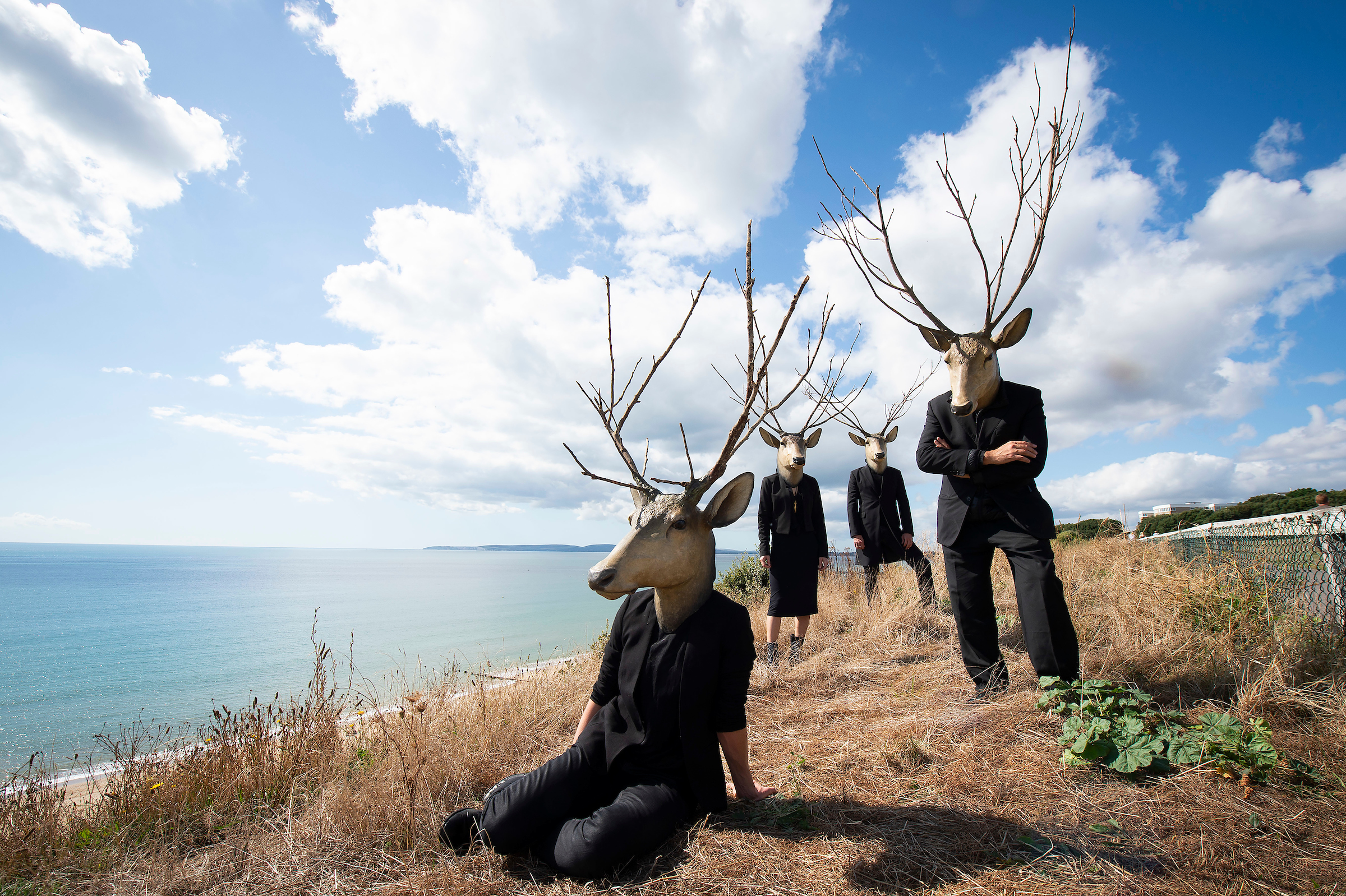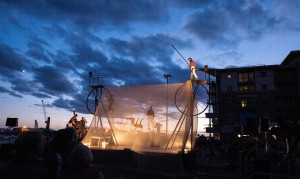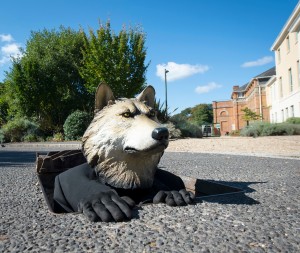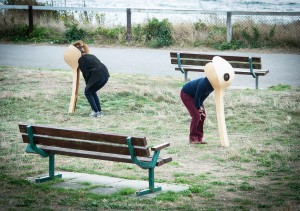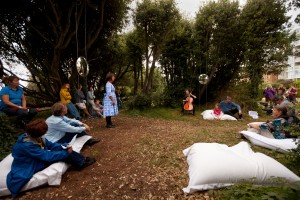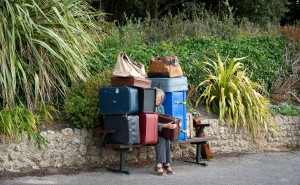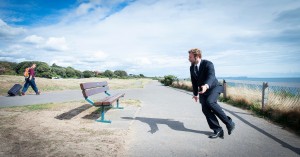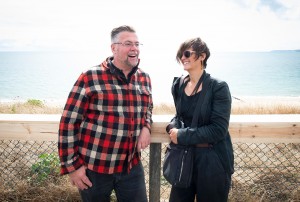A name in lights, a vintage caravan, a chorus warming up, stagehands sweeping, a band running through a soundcheck.
The houselights dim. The caravan spins to reveal an open-fronted side, showing a comfy pink-cushioned den. Two ‘ladies’ in identical embroidered satin kimonos look out. Our narrator, Dora Chance, tells us that she was born on the wrong side of the tracks (at 49 Bard Road, Brixton, South London) just five minutes before her identical twin sister, Nora – illegitimate (in every sense) daughters of a maid called Pretty Kitty, raised by the owner of the lodging house for theatricals they were born into, who they called Grandma Chance.
We look at these two bodies of varying build/gender who seem nothing like twins, and we suspend disbelief.
Today, they still live in Bard Road – although we will learn that there has been a grand life journey to get them back where they started – and they are celebrating their 75th birthdays. ‘Something will happen today’ says Dora. ‘Something exciting. Something nice, something nasty, I don’t give a monkey’s. Just as long as something happens to remind us we’re still in the land of the living.’ The ‘something’ turns out to be an invitation to attend the 100th birthday party of the great Shakespearean actor Sir Melchior Hazard, with whom they share a birthday, and who happens to be their father.
So far so good.
Wise Children is Angela Carter’s great last novel. It explores family ties in general, and paternity in particular; the magic symbolism of the twin; UK theatre and showbiz history throughout the twentieth century, high and low rubbing noses; Shakespearean tropes of identity confusion, gender reversals, and father-daughter relationship. It is bursting to the brim with ideas, beautifully written in one of English literature’s wittiest and most beguiling first-person voices. How on earth can all that translate to the stage?
This adaptation, by director Emma Rice (who probably needs no introduction, but still, here goes: director of/with Kneehigh Theatre for many years, of Shakespeare’s Globe for a shorter run – acrimonious departure, setting up of new company which shares a name with its first production, Wise Children) is the culmination of a long-held ambition. Having tackled Carter’s Nights at the Circus in 2006, she has apparently been chomping at the bit to get at this one.
And so the first question is: what is it that makes people want to adapt favourite novels for the stage? I can understand the reluctance to invent plots when so many exist already – myths, fairy tales, historical derring-dos. Shakespeare knew this, and often went for ready-made stories; Rice has usually found a suitable fairy tale or true-life story to hinge her work around. But having the skeleton of a story to build flesh on and breathe life into is very different to attempting to adapt a novel brimming with plots and sub-plots, featuring a hundred years of family history and cultural commentary, all told in a distinctive first-person voice: ‘the history of the world in evening frocks’ as Dora would have it.
The voice is the main challenge. Everything in the novel is filtered through Dora. This translates theatrically into a narrator who rattles through the telling of the tale at full speed, the resulting narrative replacing much of the distinctive wit of Carter’s Wise Children with pantomime bawdiness, as so much of the reflection and insight characteristic of Dora has to be ditched in order to fit in this incredibly long and convoluted plot. Even at two-and-a-half hours length, the show feels immensely hurried, with scenes frequently shorthanded – I wonder if anyone who hadn’t read the book could possibly keep up. And there are some very strange choices made about what to keep in and what to ditch. Oddly, in a production that has so many contributors on and off stage, the one thing missing in the credits is a writer. Or a dramaturg. Here’s a show badly in need of one or other. Preferably both. So, as far as the script goes, it’s a no.
But luckily the show does have very many other things in its favour. Dazzling dance routines from Melissa James and Omari Douglas, who play the Lucky Chances, the twins in their showgirl heyday. (One body is male, one female, and they look nothing like twins – again, we are asked to suspend disbelief – but as so much of the book, and this show, is about fantasy and illusion and role-playing, that’s fine with me.)
There are, in fact, five versions of the Chance sisters seen onstage: puppet babies in a bundle, puppet children, real-actor older children, the showgirls, and Nora and Dora aged 75, played by Etta Murfitt (who is also the company’s choreographer) and Gareth Snook. Other characters – including absent father Melchior Hazard, the great Shakespearean actor, and benevolent Uncle Peregrine – also appear in various forms, both puppet and human. Told by an Idiot’s Paul Hunter makes a splendid older Melchior, and he also appears onstage as end-of-the-pier comedian Gorgeous George, in Max Miller-ish striped socks and rude gags. George’s ‘It’s OK, he’s not your father!’ punchline is the crux of the book and show. And Hunter playing the kings of high and low culture is a nice touch. Kneehigh Theatre’s artistic director Mike Shepherd plays the older Peregrine with his usual aplomb. Katy Owen gives us an ultra-bawdy clown take on Grandma Chance that is highly skilled, but it’s an interpretation that is a little too grotesque for my taste.
The excellent puppetry, which includes the figurative work and a lovely recurring motif of fluttering butterflies on wires – comes courtesy of the Little Angel team of Lyndie and Sarah Wright. There is also a lovely animation scene, line drawings of London images projected onto the caravan. Circus gets a foot in the door in the form of contortionist and hand-balancer Mirabelle Gremaud (playing the pre-adolescent Nora Chance.) The fifteen-strong cast chop and change roles repeatedly throughout – there’s that great raft of main characters at various ages, then also all the smaller roles: the ‘legit’ Hazard twin daughters Saskia and Imogen; object of the twins’ desire, ‘the blue-eyed boy’; Melchior’s first wife Lady Atalanta (aka Wheelchair). And if not that, then there’s work to be done as a chorus member.
Music always plays a key role in Emma Rice’s productions, and here she works with Kneehigh comrades Ian Ross (the new company’s composer and musical director) and Stu Barker. The production features an eclectic mix of live and recorded music, from a repeated playing of Let’s Face the Music and Dance in different forms, to a live sleazy-jazzy version of the Louis Jordan tune Is You Is or Is You Ain’t My Baby? and an anchoring in the present-day of the narration (the 1980s) by the inclusion of a dance routine to Eddie Grant’s Electric Avenue (about Brixton, innit?) and a whole cast rendition of Cindy Lauper’s Girls Just Want to Have Fun.
The scenography carries a lot of the show. The stage within the stage is a familiar Emma Rice motif, seen repeatedly in Kneehigh shows such as The Flying Lovers, Tristan and Iseult, Rapunzel: here, we have the caravan that twirls on its axis to reveal a front parlour or a dressing room at whim; a flimsy fire curtain that drops down to allow for peeping under, or transformations behind; or the delineation of separate spaces determined by the physical actions of the actors – typical physical theatre tricks of the chorus becoming a car full of people whilst the one left behind stands and watches them gad off, or two characters playing out a stylised sex scene, seemingly invisible to others onstage. Wise Children, written in lights above the action, is cleverly manipulated to reveal key words within – Wild, for example.
Eventually, after tackling the whole of the legit Hazard and illegit Chance family histories, we come full circle, back to the birthday in 1989 that Nora and Dora share with their father, and the party they’ve been invited to (to their surprise).
Once more into the breach go the Chance sisters: sequinned mini-dresses at the ready; full make-up to be applied, because ‘the habit of applying war paint outlives the battle’. Is there resolution? Does everyone live happily ever after? The ending hurries the narrative at an even faster pace than earlier, leaving the Chance twins with another set of baby twins who have arrived with very little explanation. Again, in its desperate endeavour to be true to the novel, we have things thrust at us that haven’t been properly set up. It’s frustrating – but it is hard to know what else could have been done.
Wise Children is Carter’s best novel, and she’s one of my favourite authors – so perhaps nothing would make me happy other than just going home and re-reading the book. But it has to be said: this is not Emma Rice’s best show. I understand the standing ovation; the Old Vic audience’s obvious enthusiasm for this glittering showbiz homage. But I leave feeling dissatisfied – for all the merits of the production, it felt like a long night, and I’d have much preferred an hour-long ‘inspired by’ than this frenetic adaptation.
‘Hope for the best, expect the worst’ says Dora repeatedly. Wise words.

